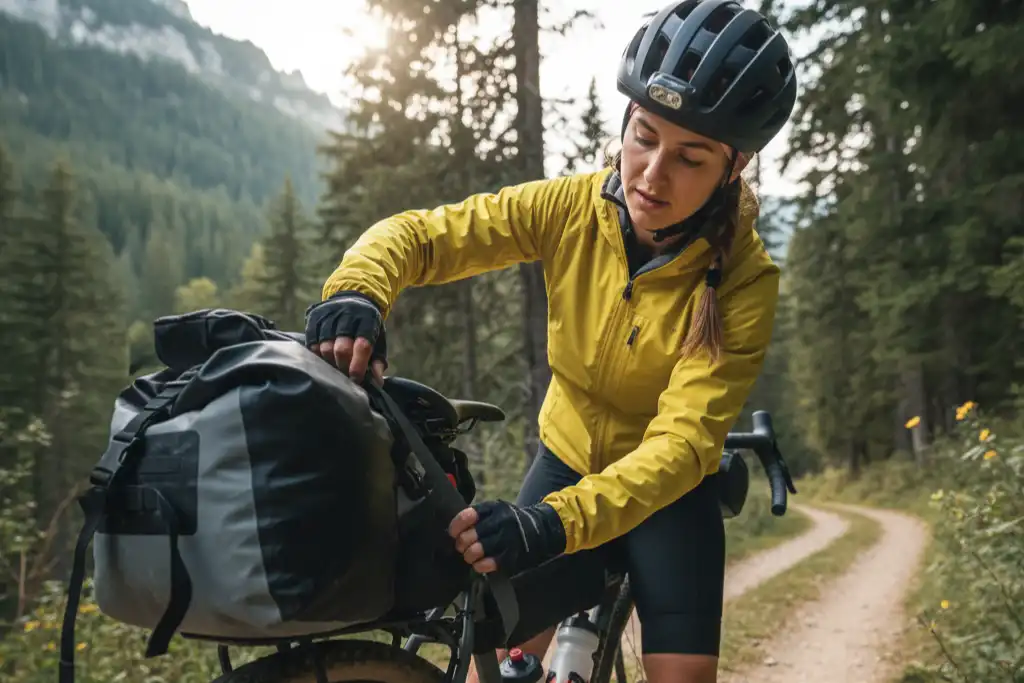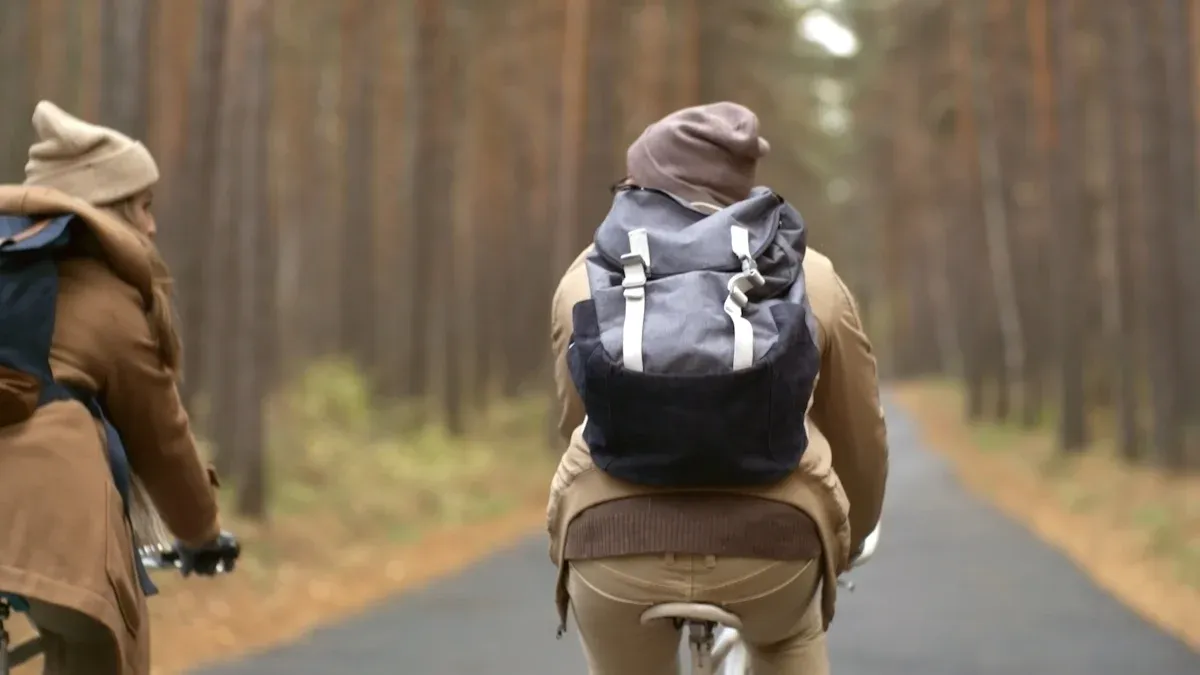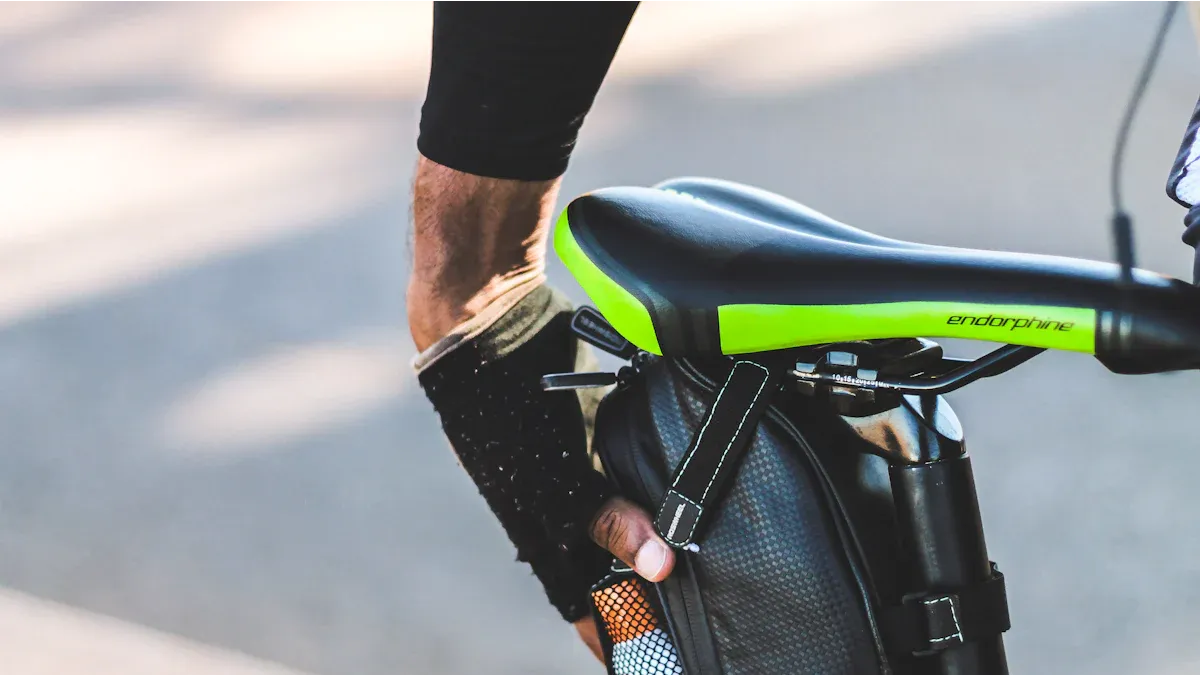How to Secure a Fixed Backpack for Safe Cycling

You want your ride to feel smooth and safe. A fixed backpack makes a big difference when you cycle. If you wear your backpack or attach it to your bike rack, you need to keep it secure. Loose straps or shifting bags can throw off your balance and distract you. When you secure your bag the right way, you protect your belongings and stay comfortable on every trip. Don’t worry—safe cycling is possible for everyone.
Key Takeaways
- Use chest and waist straps to keep your backpack still. This helps you stay balanced and comfortable when you ride your bike.
- Adjust the shoulder straps so they fit close to your body. Straps that fit right stop the bag from moving and help you stay steady.
- Keep your backpack tight to stop it from moving around. A steady bag lets you pay attention to the road and not get distracted.
- You can use bungee cords or a pannier system to attach your backpack to the bike rack. This gives extra safety and keeps your bag from falling off.
- Always check if your backpack fits well and is stable before you ride. A quick check makes sure your things are safe and you are ready for your trip.
Secure Your Fixed Backpack

Use Chest and Waist Straps
Chest and waist straps help keep your fixed backpack steady while you ride. When you buckle these straps, you stop the bag from sliding around. Wide, padded straps spread the weight across your body. This makes your ride more comfortable and helps you stay balanced. You should always check that the straps fit snugly but do not pinch. If your backpack has adjustable straps, use them to get the best fit.
Tip: Chest and waist straps do more than just hold your bag in place. They also help you avoid back pain and keep your hands free for steering.
Here are some reasons why chest and waist straps matter:
- They keep your backpack from bouncing.
- They help you stay balanced on your bike.
- They make long rides more comfortable.
If you want extra safety, look for backpacks with lock loops on the zippers and fabric that resists slashing. Some cyclists even use small carabiners or lightweight cable locks to secure their bag to the bike or to keep zippers closed.
Adjust Shoulder Straps
Shoulder straps play a big role in keeping your fixed backpack close to your body. You want the straps to feel snug but not too tight. Start by adjusting the waistband first. Then, pull the shoulder straps down and back until the pack sits firmly against your shoulders. If the straps dig in, loosen them a little. Check the sternum strap to make sure it fits well. Some backpacks have load lifters at the top. Use these to pull the weight closer to your back.
Here is a simple way to adjust your straps:
- Fasten the waistband.
- Tighten the shoulder straps.
- Adjust the chest (sternum) strap.
- Use load lifters if your backpack has them.
Note: The right strap material makes a difference. Strong straps last longer and feel better. Here is a quick look at common strap materials:
| Material Type | Width (mm) | Tensile Strength (kgf) | Key Features |
|---|---|---|---|
| Nylon 66 webbing | 50 | 1,200–1,500 | Strong, durable, ideal for heavy loads |
| Polyester webbing | 50 | N/A | UV and color stability |
| Hybrid nylon + polyester blends | 50 | N/A | Combines flexibility with low stretch |
Minimize Movement
A fixed backpack should not move much when you ride. If your bag shifts, it can throw off your balance or distract you. Make sure all straps are tight and the backpack sits high on your back. Avoid putting heavy items in outside pockets. Use hidden compartments for valuables. If your backpack has extra straps on the sides, tighten them to pull the load closer to your body.
Some backpacks have special designs that help with cycling. Look for padded backs, adjustable straps, and reflective materials. These features make your ride safer and more comfortable.
Tip: Before you start riding, give your backpack a gentle shake. If it moves or feels loose, adjust the straps again.
A fixed backpack that fits well helps you stay safe and enjoy your ride. When you take time to secure your bag, you protect your things and make cycling easier.
Attach Backpack to Bike Rack

Securing your backpack to a bike rack keeps your ride safe and stress-free. You want your fixed backpack to stay put, no matter how bumpy the road gets. Here’s how you can do it right.
Use Side Straps and Bungee Cords
Start by leaning your backpack against the saddle. If your rack has a spring, lift it before placing the bag. Use two bungee cords in an “X” shape over the backpack. This keeps the bag from sliding and stops it from touching the tire. Add a third bungee cord across the middle for extra hold. Make sure the hooks point away from the backpack to avoid snags. Nylon straps with buckles work well for odd-shaped loads. Always check that the cords and straps feel tight before you ride.
Tip: Bungee cords boost your rack’s carrying power. They help keep your backpack steady, even on rough roads.
Try a Basket or Pannier System
Baskets and pannier systems offer another way to carry your backpack. Pannier systems use strong hooks and a stiff back to keep your load secure. They stay put and make it easy to remove your bag when you stop. Baskets are simple to use and let you drop your backpack in quickly, but they may not hold heavy loads as tightly.
| Feature | Pannier Systems | Basket Systems |
|---|---|---|
| Stability | Very secure, less movement | Can shift with heavy loads |
| Security | Hooks and stiff back for extra hold | Less secure for big backpacks |
| Ease of Removal | Quick release, stays attached | Easy to remove, less stable |
| Design | Keeps load low, avoids heel strike | Bulkier, less aerodynamic |
If you ride in the rain, look for waterproof bags or use a dry bag inside your pannier. Roll-top closures keep your things dry in storms.
Add Carabiners for Extra Security
Carabiners give you another layer of safety. Attach your backpack’s top handle to the rack with a carabiner. You can also loop a bungee cord through the daisy chain on your backpack for more hold. Some riders use small pieces of innertube on the rack to stop metal-on-metal rubbing. Always check that everything feels tight before you start pedaling.
Note: Attach straps to the front of the rack to keep them away from the wheels. Give your setup a gentle shake to test for movement.
A fixed backpack that’s locked down means you can focus on the road and enjoy your ride.
Packing Tips for Balance
Distribute Weight Evenly
You want your ride to feel steady and smooth. Start by spreading the weight in your fixed backpack and on your bike. Place heavy items, like water bottles or food, close to your back or in a frame bag. This keeps the load from shifting. Use saddle bags for spare clothes or a jacket. Handlebar bags work well for snacks or documents you need to grab quickly. Top tube bags are perfect for your phone or energy bars. If you have sleeping gear or extra clothing, fork bags can hold these soft items. When you pack this way, you help your bike stay balanced.
Tip: Try to keep the heaviest things low and centered. This makes your bike easier to control.
Avoid Overpacking
Packing too much can make your ride tough. You might feel tired or lose your balance. Most riders find that carrying less than 20-30 pounds feels best. Some people can handle more, but heavy loads can cause pain or make you move slowly. Always ask yourself if you really need each item. Less is more when it comes to cycling. Focus on the essentials and leave extra stuff at home.
- Carry only what you need for the trip.
- Check the weight before you leave.
- If your bag feels too heavy, remove some items.
Secure Loose Items
Loose items can shift and throw off your balance. Use small pouches or zippered pockets to keep things in place. Food pouches or stem bags are great for snacks and small gear. Make sure everything inside your backpack stays put. If you hear things rattling, stop and fix them. A quiet bag means a safer ride.
Note: Give your backpack a gentle shake before you start. If you feel anything move, adjust it right away.
Packing smart helps you enjoy your ride and keeps you safe on the road.
Safety Checks Before Riding
Before you hop on your bike, take a few minutes to check your fixed backpack. These quick steps help you ride safely and keep your gear secure.
Test Fit and Stability
You want your backpack to feel like part of you, not something that shifts or bounces. Start by putting on your backpack and adjusting all straps. Make sure the shoulder straps sit snug but don’t pinch. Use the sternum strap and hip belt if your pack has them. Packs with ventilated hip belts and adjustable sternum straps help spread the weight. Keep heavy items close to your back and tighten compression straps to remove empty space. Give your backpack a gentle shake. If it moves or feels loose, adjust the straps again. Look for a low center of gravity so your pack stays steady, even when you ride fast or hit bumps.
- Check the fit and design for stability.
- Use all straps for even weight.
- Keep heavy items close to your back.
- Shake your backpack to test for movement.
Inspect Straps and Buckles
Straps and buckles hold everything together. You need to check them before every ride. Look for peeling metal plating, snapped clasps, or hardware that doesn’t line up. These problems can make your backpack unsafe. Use the table below to spot common issues:
| Common Issues |
|---|
| Peeling metal plating |
| Clasps or hooks snapping |
| Hardware misalignment |
Check your seat post connector and make sure the strap is locked. Look at the dropouts and confirm they are in the right spot. Make sure the top bag is seated and the pins are engaged. Roll the bag closed and zip all pockets. Tighten every buckle and strap so nothing comes loose.
Tip: For daily rides, check for stains or spills each week. Clean your straps and buckles every month. Set reminders to keep up with maintenance.
Make Final Adjustments
Now, finish with a few last tweaks. Use adjustable Velcro straps to get the best fit. If you use Velcro on your bike, add clear vinyl strips where the straps touch to protect your paint. Make sure your backpack is secure and won’t shift during your ride.
- Adjust Velcro straps for a snug fit.
- Protect your bike’s paint with vinyl strips.
- Double-check all connections before you start.
A quick safety check helps you enjoy your ride and keeps your gear safe every time.
You now know how to keep your fixed backpack secure, whether you wear it or attach it to your bike rack. Always check straps, buckles, and attachments before you ride. A fixed backpack helps you in many ways:
- Keeps your valuables safe from theft.
- Organizes your gear so nothing moves around.
- Gives you quick access to keys and cards.
Stay safe, enjoy your ride, and make every trip comfortable!
FAQ
How tight should my backpack straps be?
You want your straps snug but not uncomfortable. If you can slide two fingers under each strap, you have a good fit. Loose straps let your backpack move. Tight straps keep your bag steady.
Can I use any backpack on a bike rack?
Most backpacks work, but you get better results with ones that have sturdy handles and side straps. Soft, floppy bags may shift or fall. Try using bungee cords or carabiners for extra hold.
What if my backpack keeps sliding while I ride?
Check your straps and buckles. Tighten everything. Use side straps or bungee cords. If your bag still moves, switch to a basket or pannier system. You want your backpack to stay put.
Is it safe to carry electronics in my backpack while cycling?
Yes, you can carry electronics. Use padded sleeves or cases. Place them close to your back. Avoid putting them in outside pockets. If it rains, use a waterproof cover or bag.
How do I know if my backpack is too heavy?
Lift your backpack before you ride. If it feels hard to carry or makes you lean, it’s too heavy. Try to keep your load under 20–30 pounds. Remove items you don’t need.
See also
Backpack Shoulder Strap Tips to Fix Waistband Fit Fast
Can Hiking Help You Lose Belly Fat? Top Tips for Success



Comments are closed